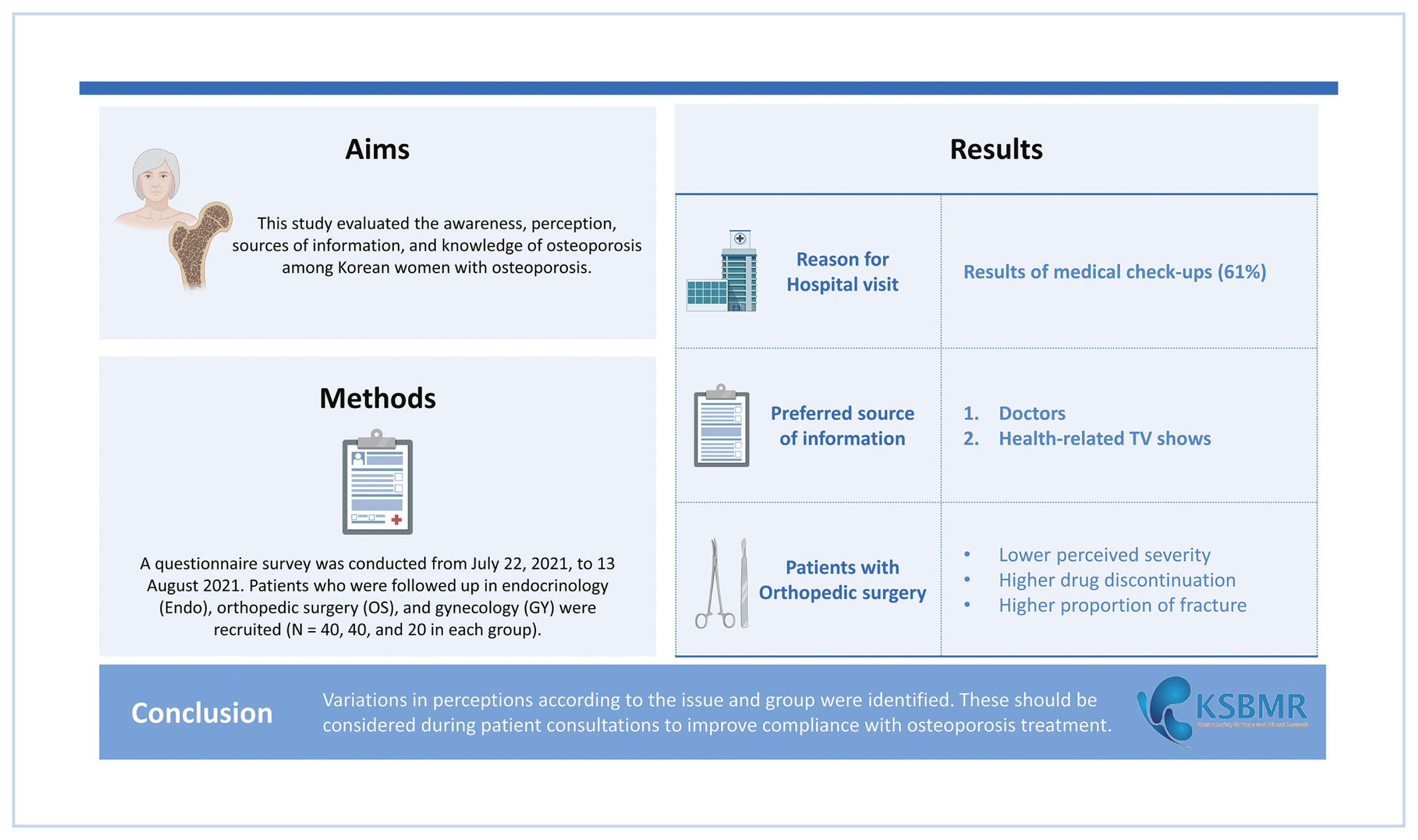1. NIH Consensus Development Panel on Osteoporosis Prevention, Diagnosis, and Therapy. Osteoporosis prevention, diagnosis, and therapy. JAMA 2001;285:785-95.
https://doi.org/10.1001/jama.285.6.785.


3. Kanis JA, McCloskey EV, Johansson H, et al. European guidance for the diagnosis and management of osteoporosis in postmenopausal women. Osteoporos Int 2013;24:23-57.
https://doi.org/10.1007/s00198-012-2074-y.



5. Ko KR, Lee S, Oh SY, et al. Long-term oral bisphosphonate compliance focusing on switching of prescription pattern. Patient Prefer Adherence 2020;14:2009-16.
https://doi.org/10.2147/ppa.S266697.



6. Netelenbos JC, Geusens PP, Ypma G, et al. Adherence and profile of non-persistence in patients treated for osteoporosis-a large-scale, long-term retrospective study in The Netherlands. Osteoporos Int 2011;22:1537-46.
https://doi.org/10.1007/s00198-010-1372-5.



12. Cramer JA, Amonkar MM, Hebborn A, et al. Compliance and persistence with bisphosphonate dosing regimens among women with postmenopausal osteoporosis. Curr Med Res Opin 2005;21:1453-60.
https://doi.org/10.1185/030079905x61875.


13. Castle D. Perceptions of health and illness: current research and applications. In: Petrie KJ, Weinman JA, Harwood Academic Publishers; New York: 1998. editors. Psychol Med. 1999. 29:p.1467. -80.

14. Giangregorio L, Dolovich L, Cranney A, et al. Osteoporosis risk perceptions among patients who have sustained a fragility fracture. Patient Educ Couns 2009;74:213-20.
https://doi.org/10.1016/j.pec.2008.08.001.



15. Giangregorio L, Papaioannou A, Thabane L, et al. Do patients perceive a link between a fragility fracture and osteoporosis? BMC Musculoskelet Disord 2008;9:38.
https://doi.org/10.1186/1471-2474-9-38.



16. Carr AJ, Thompson PW, Cooper C. Factors associated with adherence and persistence to bisphosphonate therapy in osteoporosis: a cross-sectional survey. Osteoporos Int 2006;17:1638-44.
https://doi.org/10.1007/s00198-006-0166-2.


17. McHorney CA, Schousboe JT, Cline RR, et al. The impact of osteoporosis medication beliefs and side-effect experiences on non-adherence to oral bisphosphonates. Curr Med Res Opin 2007;23:3137-52.
https://doi.org/10.1185/030079907x242890.


19. Kendler DL, Macarios D, Lillestol MJ, et al. Influence of patient perceptions and preferences for osteoporosis medication on adherence behavior in the Denosumab Adherence Preference Satisfaction study. Menopause 2014;21:25-32.
https://doi.org/10.1097/GME.0b013e31828f5e5d.


20. Papaioannou A, Morin S, Cheung AM, et al. 2010 Clinical practice guidelines for the diagnosis and management of osteoporosis in Canada: summary. CMAJ 2010;182:1864-73.
https://doi.org/10.1503/cmaj.100771.



21. Choi YJ, Shin HB, Park B, et al. Temporal change in the diagnosis and treatment rates of osteoporosis: results from the Korea National Health and Nutrition Examination Survey. Osteoporos Int 2021;32:1777-84.
https://doi.org/10.1007/s00198-021-05864-z.



22. Kim HS. Research on the bone mineral densitometer quality control and the precision test of radio-technologists by dual energy x-ray absorptiometry (DXA) at metropolitan area hospital. J Radiat Ind 2018;11:283-9.
25. Friedman D, Donner EJ, Stephens D, et al. Sudden unexpected death in epilepsy: knowledge and experience among U.S. and Canadian neurologists. Epilepsy Behav 2014;35:13-8.
https://doi.org/10.1016/j.yebeh.2014.03.022.



26. Schwab C, Wadle NE, Knake S, et al. Patients’ knowledge about epilepsy-related risks, morbidity, and mortality: a multicenter cohort study from Germany. Epilepsy Behav 2021;124:108343.
https://doi.org/10.1016/j.yebeh.2021.108343.


27. Beaudart C, Sharma M, Clark P, et al. Patients’ preferences for fracture risk communication: the Risk Communication in Osteoporosis (RICO) study. Osteoporos Int 2024;35:451-68.
https://doi.org/10.1007/s00198-023-06955-9.



28. Ribeiro V, Blakeley J, Laryea M. Women’s knowledge and practices regarding the prevention and treatment of osteoporosis. Health Care Women Int 2000;21:347-53.
https://doi.org/10.1080/073993300245195.


29. Ahmadieh H, Basho A, Chehade A, et al. Perception of peri-menopausal and postmenopausal Lebanese women on osteoporosis: a cross-sectional study. J Clin Transl Endocrinol 2018;14:19-24.
https://doi.org/10.1016/j.jcte.2018.10.001.



30. Morin SN, Djekic-Ivankovic M, Funnell L, et al. Patient engagement in clinical guidelines development: input from >1000 members of the Canadian Osteoporosis Patient Network. Osteoporos Int 2020;31:867-74.
https://doi.org/10.1007/s00198-019-05248-4.



32. Barańska A, Religioni U, Drop B, et al. Assessment of the level of satisfaction with medical care of patients treated in osteoporosis clinics as an indicator of the quality of medical care. Int J Environ Res Public Health 2022;19:7343.
https://doi.org/10.3390/ijerph19127343.



33. Jakobsen PR, Hermann AP, Søndergaard J, et al. Left in limbo - Experiences and needs among postmenopausal women newly diagnosed with osteoporosis without preceding osteoporotic fractures: a qualitative study. Post Reprod Health 2018;24:26-33.
https://doi.org/10.1177/2053369118755189.


34. Saravanakumari AD, Selvi DT, Kumar RR, et al. Assessment of patient satisfaction with inpatient services at secondary level setting. Public Health Rev Int J Public Health Res 2020;7:58-65.
https://doi.org/10.17511/ijphr.2020.i06.03.

37. Litwic AE, Westbury LD, Carter S, et al. Self-perceived fracture risk in the global longitudinal study of osteoporosis in women: its correlates and relationship with bone microarchitecture. Calcif Tissue Int 2020;106:625-36.
https://doi.org/10.1007/s00223-020-00680-9.



38. Siris ES, Gehlbach S, Adachi JD, et al. Failure to perceive increased risk of fracture in women 55 years and older: the global longitudinal study of osteoporosis in women (GLOW). Osteoporos Int 2011;22:27-35.
https://doi.org/10.1007/s00198-010-1211-8.



40. Cornelissen D, Boonen A, Bours S, et al. Understanding patients’ preferences for osteoporosis treatment: the impact of patients’ characteristics on subgroups and latent classes. Osteoporos Int 2020;31:85-96.
https://doi.org/10.1007/s00198-019-05154-9.
















 PDF Links
PDF Links PubReader
PubReader ePub Link
ePub Link Full text via DOI
Full text via DOI Download Citation
Download Citation Print
Print



